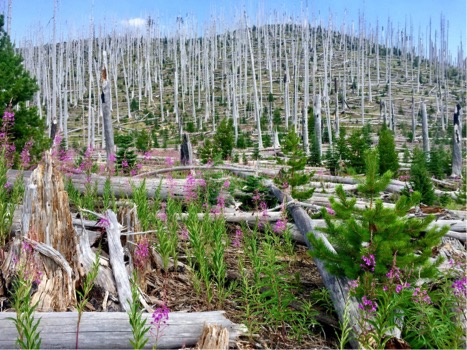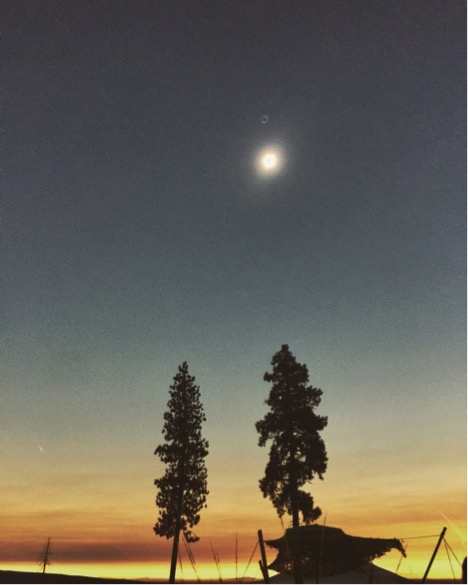[Guest Story] 300 Miles
A former stewardship intern and recent seasonal employee, Nathan Kossnar, reflects on his journey on the Pacific Crest Trail and his work for Columbia Land Trust.
I have spent the last two summers with Columbia Land Trust’s stewardship team; last year as an intern and most recently as a seasonal employee this summer. This August, I was fortunate enough to take personal time off to hike along the Oregon Cascades from Crater Lake National Park to the Columbia River Gorge, a trip totaling 300 miles across some of the most beautiful terrain the state has to offer; Mount Thielson, Diamond Peak, Three Sisters, Mount Washington, Three Fingered Jack, Mount Hood, and ending at the Oregon-Washington border, the Land Trust’s namesake, the mighty Columbia River.
 My fellow hiker, Zack, and I set off alongside our dogs on the morning of August 2nd from the northern boundary of Crater Lake National Park. We narrowly dodged wildfire closures nearly the entire trip, including closures from both Crater Lake and Three Sisters’ fires. If we had been only one day behind, these wildfires would have abbreviated our hike by over 100 miles.
My fellow hiker, Zack, and I set off alongside our dogs on the morning of August 2nd from the northern boundary of Crater Lake National Park. We narrowly dodged wildfire closures nearly the entire trip, including closures from both Crater Lake and Three Sisters’ fires. If we had been only one day behind, these wildfires would have abbreviated our hike by over 100 miles.
Determining what we needed to survive on the trail for a whole month was daunting. We researched resupply points and ended up shipping food to resorts along the way, only needing to carry one week’s worth of food at any given time. We lived on a diet of oats and grains for 27 days, minus the occasional meal when we reached civilization.
Shortly after committing to our hike, we realized that it would take minimal planning adjustments to make it to the path of totality for the solar eclipse on August 21st. After outrunning the Milli Fire in Three Sisters’ Wilderness (never in harm’s way, only at risk of stopping for trail closures), we found ourselves ahead of schedule and only 20 miles from our destination for the eclipse. We decided to find a ride into Sisters, Oregon to spend our additional time resting and resupplying before hitting our next leg. Within five minutes of standing on the side of the highway, a local recognized us to be Pacific Crest Trail (PCT) hikers and happily shuffled some work gear around in his station wagon to accommodate both us and our dogs. In Sisters, we decided to take a siesta and find a dog-friendly motel. We were hungry and dirty. As our time was running out in Sisters, we scrambled to find a way 28 miles east on McKenzie Highway back to the trailhead. By another stroke of luck, we made it back to the trailhead only an hour before Highway 242 was closed to fight the aggressively spreading Milli Fire.
 Back on the trail, we reached out to our friend who had mentioned an eclipse gathering of Portland friends down near Three Fingered Jack. We plugged the coordinates into GPS and started heading off the PCT via connecting lake trails, eventually finding ourselves at the given location, a hilltop in Mt. Jefferson Wilderness with a 360-degree view of Mt. Jefferson, Black Butte, Mt. Washington, and Three Fingered Jack. A perfect setting for what would end up being a once-in-a-lifetime event. After the eclipse, we shuffled around the Mt. Jefferson Whitewater Fire and began our final stretch towards Cascade Locks.
Back on the trail, we reached out to our friend who had mentioned an eclipse gathering of Portland friends down near Three Fingered Jack. We plugged the coordinates into GPS and started heading off the PCT via connecting lake trails, eventually finding ourselves at the given location, a hilltop in Mt. Jefferson Wilderness with a 360-degree view of Mt. Jefferson, Black Butte, Mt. Washington, and Three Fingered Jack. A perfect setting for what would end up being a once-in-a-lifetime event. After the eclipse, we shuffled around the Mt. Jefferson Whitewater Fire and began our final stretch towards Cascade Locks.
Before this trip, I had never come close to a hike of this size, and my friends and family said we were crazy for trying to attempt this journey. However, once on the trail, thru-hikers (those who hike the entire 2,650-mile trail from Mexico to Canada) thought we were crazy for only hiking our 300-mile section. It was an incredibly inspiring experience seeing folks of all ages, abilities, and backgrounds dedicating four to six months to this life-changing endeavor.
Yet many of us do not have the same resources, time, access, and abilities to take journeys like these. I believe that all people should have the same opportunities to experience the nature in some form, whether through day hikes, river trips, visits to urban parks, or full-on PCT adventures. In these moments, one learns how truly important nature is, how we depend on it for our survival, and how nature has the ability to shift our attitudes about ourselves and our world. Conservation and outdoor industries will need to become stronger voices for inclusive, welcoming outdoor experiences both far afield and close to home.
Talking to hikers along the way, we heard a few stories of the trail and its existence decades ago. Back then, the PCT was not yet a continuous 2,650-mile trail from Mexico to Canada, as it stands today. Hikers of past generations were stuck walking highways routes between trailheads to continue their journey and access wilderness areas across the West. As a contributor to a conservancy group, this idea of land use and access intrigued me. The Pacific Crest Trail Association uses the same tools as Columbia Land Trust for conservation. Acquisitions of conservation easements and fee title lands have protected 90 percent of the trail since its designation nearly 50 years ago as a National Scenic Trail by Congress. Just as the Pacific Crest Trail protects its legacy for hikers of future generations, Columbia Land Trust protects the beloved natural areas of the Pacific Northwest. But just as the PCT isn’t the same without the hikers, Columbia Land Trust isn’t the same without you, the purveyors of nature’s inherent value.
I would like to thank Sarah Richards for making this piece a reality, my friend Zack Trecker for putting up with me for a month and filling in the gaps of our trip, and the entirety of Columbia Land Trust for doing what they do with such passion; it’s truly inspiring.
-Nathan Kossnar
